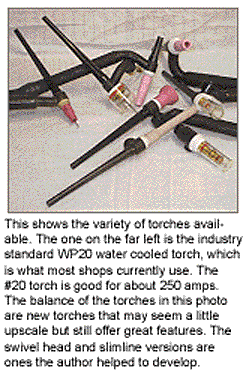
Like the swallows coming back to Capistrano, the monarch butterflies finding the same wintering site in Mexico generation after generation or the buzzards returning faithfully to Hinckley, OH, in my neck of the woods, I am back with an annual March update on TIG welding in general and welding aluminum cylinder heads and other engine components in particular.
Rather than revisiting the past two articles I wrote for Engine Builder (“The How’s and Whys of Welding Aluminum, March 2003, and “TIG Welding Opportunities,” March 2004), this feature will focus on new products, tools, machine features and safety products that are available to the market this year.
I’d first like to touch briefly on some of the incomplete or inaccurate information about welding aluminum that has been circulating for years. There’s a lot that you should know and a lot of places you can get the information. It is then in your hands how much you want to learn.
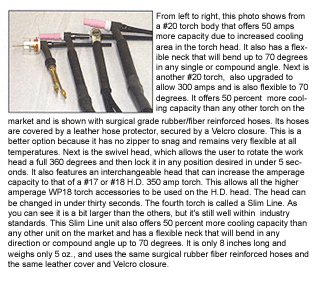
Information presented as gospel in the past has implied or stated outright that aluminum heads and blocks are made of 356 or T356 aluminum with a T6 heat treatment, and therefore can create severe problems in the cleaning and welding of aluminum engine components.
Let me be very clear here: that statement is simply not the fact. Not to say it is an incorrect statement, it is just very incomplete and can lead to a lot of confusion when researching the methods required for cleaning and welding aluminum engine components.
The alloys used in the manufacture of engine components that we weld regularly are as follows
204.0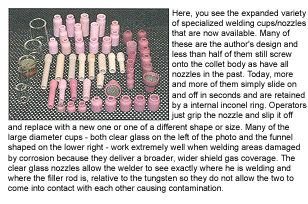
206.0
242.0
308.0
319.0
356.0
A356.0
357.0
A357.0
358.0
359.0
360.0
384.0
390.0
Obviously, this means there are many more alloys in use than commonly thought. Many of these alloys are not heat treated in the T5-6-7-8 manner but rather derive their specific strengths by their alloying agents. In other words, the agents used in the “recipe,” if you will, deliver the necessary properties to be suitable for whatever engine component they are intended.
However, detailing the specifics of these alloys could fill the next ten issues of Engine Builder so I will stop here and simply say, “Not all is what it appears to be.” Given the variety of alloys used, and the number of readers who might want more information regarding their effects and procedures to weld them, I think it might be easier to send me an e-mail to the address at the end of this article. I will send you the necessary links to all the information you want to explore.
However, let me reassure you that welding can successfully repair all of these alloys.
The Safety Equipment
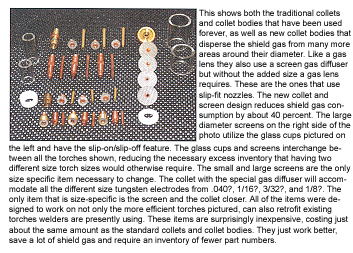
The runways of Milan and New York are full of people looking for the latest fashion trend. In welding, fashion usually takes a back seat to function but the latest advancements in helmet design needs to be addressed. “Auto darkening” helmets now have many “light” options, choices as vast as colors in the rainbow. Some will prove more valuable then others.
Most helmets now offer a delay adjustment to protect the welder from outside influences such as lighting or sparks that might cause the shield to either darken or release darkening inadvertently.
Other features worth looking into include an adjustable on-off delay. This function allows the welder to set the parameters for the on-off time, which is very useful when just spot welding or tacking or for deciding how quickly he or she wants the lens to revert to off when the weld is completed.
Many auto darkening helmets now offer complete protection whether on or off from ultraviolet and infrared rays. Most manufacturers are offering variable shade adjustments from 9-14. Further, they offer a shade protection of #3-#5 in the off cycle to allow easy grinding with the helmet on, meaning you no longer have to remove your helmet and use safety glasses and then put the helmet back on again to weld.
In addition, for those of you who prefer to weld without your glasses or contacts on or who just prefer a more adjustable headgear, a variety of magnifiers are available.
Away from the face but just as important to your safety and comfort, gloves for handling the hot castings from the pre-heat oven to the welding table have made similar advancements. We now have lighter, more comfortable gloves that can withstand the temperatures better then in the past. Protective sleeves are now made in safer, more comfortable materials as well, which will protect the welder from ultraviolet and infrared light, as well as arc burns and contact burns and just makes for a better welding environment.
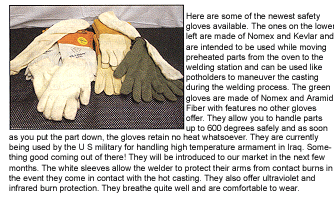
And don’t forget your neck and upper body areas. They too need protection, and some new protective gear made of lightweight man-made fibers rather than leather is available.
Tool Talk
When you look into some of the newest tools available for TIG welding, certainly we need to start with the torch or torches we will be using. The big story here is ergonomics. As you’ll see in the photography accompanying this article, there are several new, better and smaller torches that all offer easier access to hard-to-reach areas and still retain amperage capacity.
The torches shown on page 38 all include better hose covers than were available in the past. Just like the hose they protect, the covers are more flexible than ever and have NO zippers – the space age miracle of Velcro® closures now makes it easier to access the torch or hose.
As with the torch, the Tungsten electrode comes in a variety of styles. And, similar to the dizzying array of aluminum alloys being used in engine component casting, there are currently almost twenty different Tungsten alloys available for welding. But, lest you worry that you’ll need to match a Tungsten to each specific aluminum alloy, breathe easy. In the case of Tungstens, the choice is much easier to make.
In the past I have written about and recommended Ceriated Tungstens and, as of now, even with all the different styles available, I would still recommend either 2 percent Ceriated or 1 to-1.5 percent or 2 percent Lanthanated. Both types are the top choices for aluminum and magnesium and each offer their own benefits.
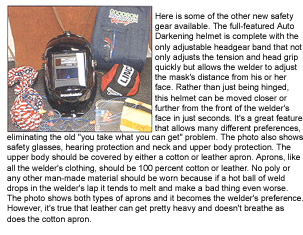
What we should be looking for in a Tungsten would be the restarting properties and that they do not “frost” at low amperage, “split,” or degrade or decompose causing weld pool contamination resulting in porosity problems. Both Cerieted and Lanthanated Tungstens do well at this, making it a matter of operator preference and machine settings.
After the Tungsten come the torch cups or nozzles. Many new styles are available today; some allow better access, some no longer require being screwed on the collet body (they simply slip on and off the collet body). The collet body is now available with a gas diffuser and screen. Unlike a gas lens, these new little guys will give you better laminar gas flow and save up to forty percent of the shield gas you are using over a traditional collet body. And best of all, they are no larger than the traditional collet bodies, they simply offer better gas coverage and gas savings.
Although it’s exciting news that some slip on and off, that is just the beginning. Some cups are now being made of a see-through material, so for some jobs this would be like having no cup on the torch, which would limit visibility. While they are a bit more sensitive to handling, they handle the heat quite well and the benefits are great.
There is now an accessory kit that includes these slip-on cups and more efficient collet bodies and screens available for retrofitting your existing torch.
Another style of torch is available that, rather than simply offering the “flex” head feature, has a head that can be rotated 360 degrees around the torch body. Talk about being flexible – this is as good as it gets!
This torch uses the standard #20 torch accessories and – get this – can lose its head in about 15 seconds and be replaced by a #17- #18 type head that still swivels 360 degrees and increases the amperage range to that of a 350 amp torch.
All of these new torches can share the special collets, gas screens and nozzles. As you can see in the photos with the accessories, there are clear cups that use a 1-1/8? I.D. clear nozzle for covering large areas without the need for a purge or trailing cup or fixtures.
Finally, there is an Alumina funnel-shaped nozzle (dimensions 1? i.d. by 1.250? long) that fits a small #20 gas lens and has its own diffuser screens and protector. It, too, helps greatly with expanded gas coverage and like the large clear nozzles offers gas savings and longer tungsten stick out for hard-to-reach areas. These large nozzles, whether clear or Alumina, are just great for repairing areas with corrosion damage since they give better shielding protection.
Welding machines, too, have undergone significant changes. The machines we use offer three very useful features. The patented “Micro Start Technology” offers an arc start for DC as low as 2 amps and for AC 5 amp arc starts. This greatly needed feature allows us to start an arc at extremely low amperage preventing burn through in thin areas and further allows the operator to view the area that is to be welded without the melting to occur until the operator is ready. We also enjoy the “Auto Balance” control that, should you desire, will make automatic balance adjustments during welding based on the amperage input. Again, it’s a feature necessary for quality work that requires no operator input. In addition, today’s machines still offer the traditional “set-it-yourself” balance control.
TIG welding machines from Lincoln Electric come equipped with a pulsing feature that allows higher amperage input and rapidly dropping input, fully adjustable that allows for more amperage input without the risk of burn through while transitioning from a thick area to a thin area of the casting.
This feature, an option on most every brand of TIG welding equipment, really is a necessity. However, many times, due to cost considerations, the option isn’t selected and so the welder loses. In essence, it’s the difference between getting a stripped down basic car or the fully-loaded sedan. Both will provide basic transportation but one OEM includes the radio, hubcaps and floormats. A smart choice early means you’re not suffering through until the payment book is empty.
So between this article and the two previous articles, you should know just about everything there is to know about welding aluminum. If not, thought, contact me. We are operating a training school in the areas of casting repair and salvage. The school is equipped to address all areas of crack repair and all current methods of crack repair for both non-ferrous and ferrous metals. If you are interested in knowing more about it, please send me an email.
If you’d like to give me your questions, comments or concerns, I encourage you to send me an email. I would like to thank Lincoln Electric and Goodson Shop Supplies for the unwavering support they have given us to allow us to help you. In addition, thanks to the folks at Engine Builder magazine for once again allowing me to share what I know with you, the readers.
Built-in PulserWhat is it? Results: Better control of heat input in the weld resulting in: Reduced warping and burn through on thin materials. Smaller heat affected zone. Smaller bead profile without compromising proper penetration. Help train novice welders to maintain a steady More welding control makes welding easier |
AC Auto Balance ControlsWhat is it? Results: The AC Auto Balance automatically adjusts the Great for novice welders – set it and forget it for most AC welding applications. Expert welders – use either the AC Auto Balance auto setting or manually set the cleaning and Achieve better welds with minimal fuss!!! |
Micro Start TechnologyWhat is it? Results: Minimizes excessive hot starts normally required to establish the arc. Reduces intense high frequency wandering and tungsten frosting during starting. Allows you to weld with greater stability at low amperage. Reduces the risk of melting away material on |













